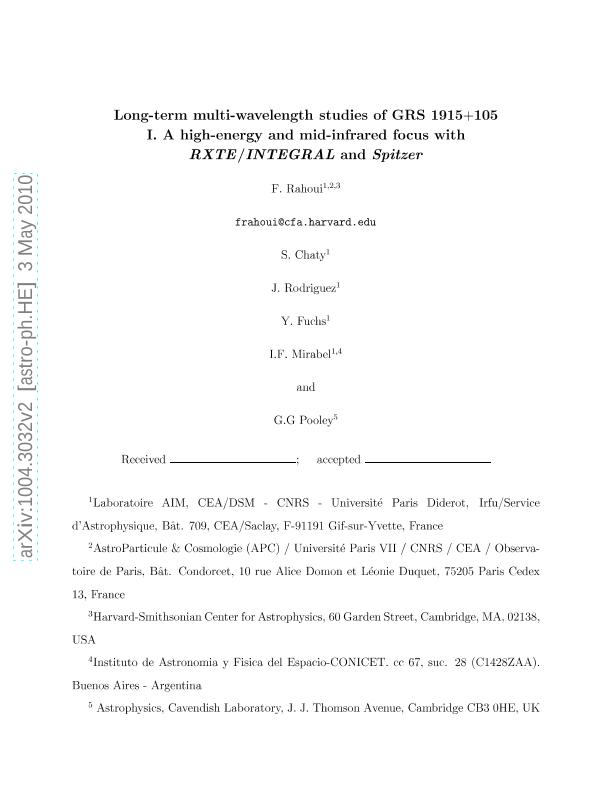Mostrar el registro sencillo del ítem
dc.contributor.author
Rahoui, F.
dc.contributor.author
Chaty, S.
dc.contributor.author
Rodriguez, J.
dc.contributor.author
Fuchs, Y.
dc.contributor.author
Mirabel Miquele, Igor Felix

dc.contributor.author
Pooley, G. G.
dc.date.available
2017-07-12T19:35:26Z
dc.date.issued
2010-06
dc.identifier.citation
Rahoui, F.; Chaty, S.; Rodriguez, J.; Fuchs, Y.; Mirabel Miquele, Igor Felix; et al.; Long-term multi-wavelength studies of GRS 1915+105. I. A High-energy and mid-infrared focus with RXTE/INTEGRAL and SPitzer; IOP Publishing; Astrophysical Journal; 715; 2; 6-2010; 1191-1202
dc.identifier.issn
0004-637X
dc.identifier.uri
http://hdl.handle.net/11336/20255
dc.description.abstract
To date, mid-infrared properties of Galactic black hole binaries have barely been investigated in the framework of multi-wavelength campaigns. Yet, studies in this spectral domain are crucial to get complementary information on the presence of dust and/or on the physical processes such as dust heating and thermal bremsstrahlung. Here, we report a long-term multi-wavelength study of the microquasar GRS 1915+105. On the one hand, we aimed at understanding the origins of the mid-infrared emission, and on the other hand, at searching for correlation with the high-energy and/or radio activities. We observed the source at several epochs between 2004 and 2006 with the photometer IRAC and spectrometer IRS, both mounted on the Spitzer Space Telescope. When available, we completed our set of data with quasi-simultaneous RXTE/INTEGRAL high-energy and/or Ryle radio observations from public archives. We then studied the mid-infrared environment and activities of GRS 1915+105 through spectral analysis and broadband fitting of its radio to X-ray spectral energy distributions. We detected polycyclic aromatic hydrocarbon molecules in all but one IRS spectra of GRS 1915+105 which unambiguously proves the presence of a dust component, likely photoionized by the high-energy emission. We also argue that this dust is distributed in a disk-like structure heated by the companion star, as observed in some Herbig Ae/Be and isolated cool giant stars. Moreover, we show that some of the soft X-ray emission emanating from the inner regions of the accretion disk is reprocessed and thermalized in the outer part. This leads to a mid-infrared excess that is very likely correlated to the soft X-ray emission. We exclude thermal bremsstrahlung as contributing significantly in this spectral domain.
dc.format
application/pdf
dc.language.iso
eng
dc.publisher
IOP Publishing

dc.rights
info:eu-repo/semantics/openAccess
dc.rights.uri
https://creativecommons.org/licenses/by-nc-sa/2.5/ar/
dc.subject
Accretion
dc.subject
Acrettion Disks
dc.subject
Binaries: Close, Dust, Extinction
dc.subject
Grs 1915+105
dc.subject.classification
Astronomía

dc.subject.classification
Ciencias Físicas

dc.subject.classification
CIENCIAS NATURALES Y EXACTAS

dc.title
Long-term multi-wavelength studies of GRS 1915+105. I. A High-energy and mid-infrared focus with RXTE/INTEGRAL and SPitzer
dc.type
info:eu-repo/semantics/article
dc.type
info:ar-repo/semantics/artículo
dc.type
info:eu-repo/semantics/publishedVersion
dc.date.updated
2017-07-12T14:45:32Z
dc.journal.volume
715
dc.journal.number
2
dc.journal.pagination
1191-1202
dc.journal.pais
Reino Unido

dc.journal.ciudad
Londres
dc.description.fil
Fil: Rahoui, F.. Université Paris Diderot - Paris 7; Francia
dc.description.fil
Fil: Chaty, S.. Université Paris Diderot - Paris 7; Francia
dc.description.fil
Fil: Rodriguez, J.. Université Paris Diderot - Paris 7; Francia
dc.description.fil
Fil: Fuchs, Y.. Université Paris Diderot - Paris 7; Francia
dc.description.fil
Fil: Mirabel Miquele, Igor Felix. Consejo Nacional de Investigaciónes Científicas y Técnicas. Oficina de Coordinación Administrativa Ciudad Universitaria. Instituto de Astronomía y Física del Espacio. - Universidad de Buenos Aires. Facultad de Ciencias Exactas y Naturales. Instituto de Astronomía y Física del Espacio; Argentina
dc.description.fil
Fil: Pooley, G. G.. Astrophysics, Cavendish Laboratory; Reino Unido
dc.journal.title
Astrophysical Journal

dc.relation.alternativeid
info:eu-repo/semantics/altIdentifier/doi/http://dx.doi.org/10.1088/0004-637X/715/2/1191
dc.relation.alternativeid
info:eu-repo/semantics/altIdentifier/url/http://iopscience.iop.org/article/10.1088/0004-637X/715/2/1191/meta
dc.relation.alternativeid
info:eu-repo/semantics/altIdentifier/url/https://arxiv.org/abs/1004.3032
Archivos asociados
